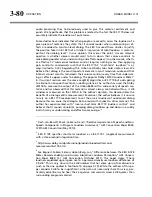
3-78
OPERATION
ORBAN MODEL 1101
the CBS algorithm via the “CBS Gain” control, setting it 3 dB higher could better
match the CBS long-term measurement to the BS.1770-2 Integrated measurement at
the expense of moving the “maximum peak loudness” indication 3 dB higher.
Results
Unprocessed Audio Input:
To provide a baseline for discussion of the loudness-
controlled results, we measured the unprocessed audio that was applied to the Op-
timod 8685’s input. Figure 3-6 and Figure 3-7 on page 3-75 show the loudness of the
unprocessed audio both as a function of time and as a histogram. The histogram
sorts the meter outputs into 0.25 dB or 0.25 LK
-wide slices and shows the number of
measurements that fit into each of these slices. The histogram thus portrays loud-
ness consistency — when the histogram is clustered tightly within a few bins, the
loudness is more consistent than it is when the histogram is spread out into a larger
number of bins.
With all meters, the histogram of the unprocessed audio shows a wide spread. This is
consistent with the EBU Loudness Range measurement for the entire clip, which was
16.5 LK, while the LRA for the daytime drama alone was 19.2 LK (including commer-
cials). The BS.1770-2 Integrated loudness was –20 LKFS, integrated over the entire
measurement period, although the inconsistencies between the loudness of pro-
gram material and commercials are large enough to make this 30-minute measure-
ment essentially meaningless.
In general, the loudest parts of the unprocessed audio are commercials and promos,
both network and local. These are anywhere from 5 to 10 dB (or LK) louder than the
rest of the program material. This inconsistency was not a problem because the sta-
tion in question was using an Orban automatic loudness controller on-air, which
smoothed out loudness differences before its input.
While the general shapes of the CBS and BS.1770 loudness vs. time curves are similar,
there were some significant differences. For example at approximately 1250 seconds,
the CBS measurement shows a sharp loudness spike that was caused by a network
news report that was equalized to emphasize frequencies around 2 to 3 kHz, where
the ear is most sensitive. The BS.1770-2 measurement did not indicate this as being
louder than the surrounding program material although to our ears, it clearly was.
Loudness-Controlled Audio:
Figure 3-8 and Figure 3-9 on page 3-76 show the results
after automatic loudness control. (To present the data with optimum graphic resolu-
tion, we made the loudness scales of Figure 3-8 and Figure 3-9 narrower than the
scales in Figure 3-6 and Figure 3-7.)
Both the loudness vs. time graphs and the histograms show the Orban 8685 controls
loudness well, although the details of the meters’ indications are different. Both the
7
Unfortunately, two terms for the same loudness units have been used in different
standards documents. For convenience, we will use LK and LKFS (as used in ATSC
A/85); these units are the same as LU and LUFS (used in EBU R 128 and BS.1770) re-
spectively.
Summary of Contents for Optimod-PC 1101
Page 4: ......
Page 14: ......
Page 121: ...OPTIMOD PC OPERATION 3 1 Section 3 Operation Figure 3 1 The OPTIMOD PC Control Application...
Page 192: ...3 72 OPERATION ORBAN MODEL 1101...
Page 204: ......
Page 210: ......
Page 212: ...5 2 UNINSTALLATION ORBAN MODEL 1101...
Page 236: ......






























